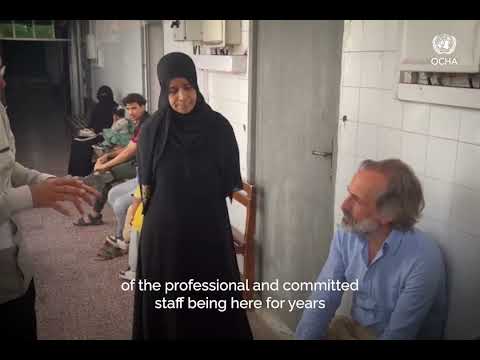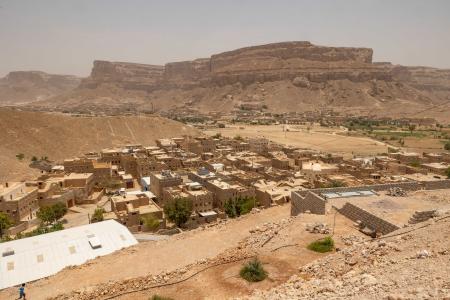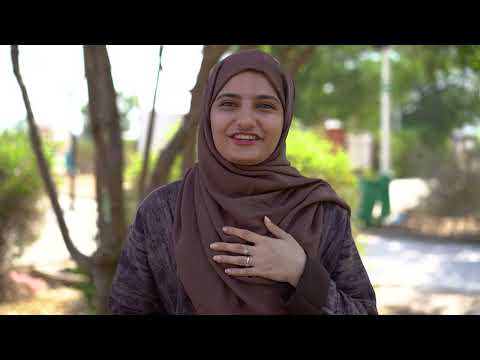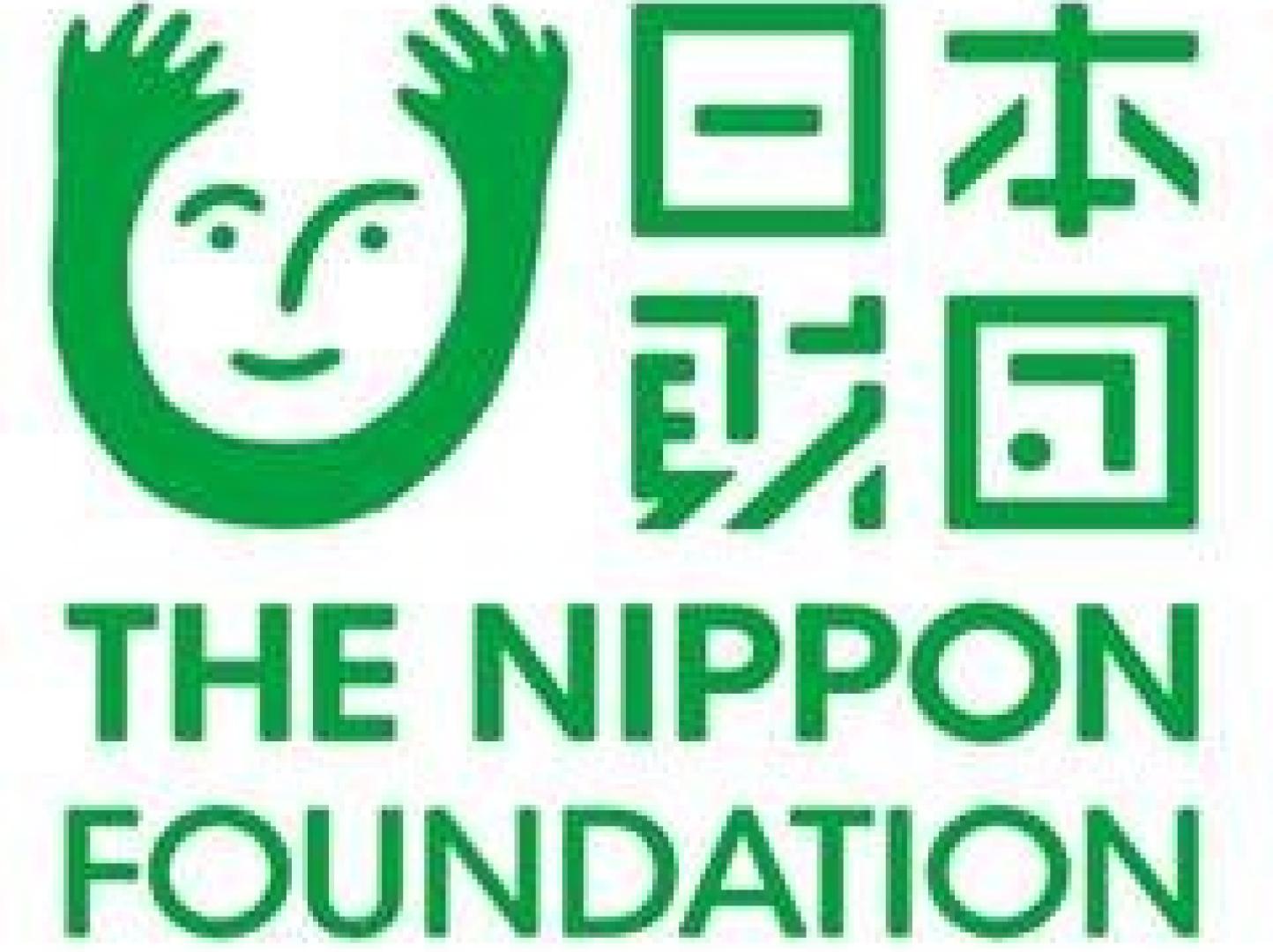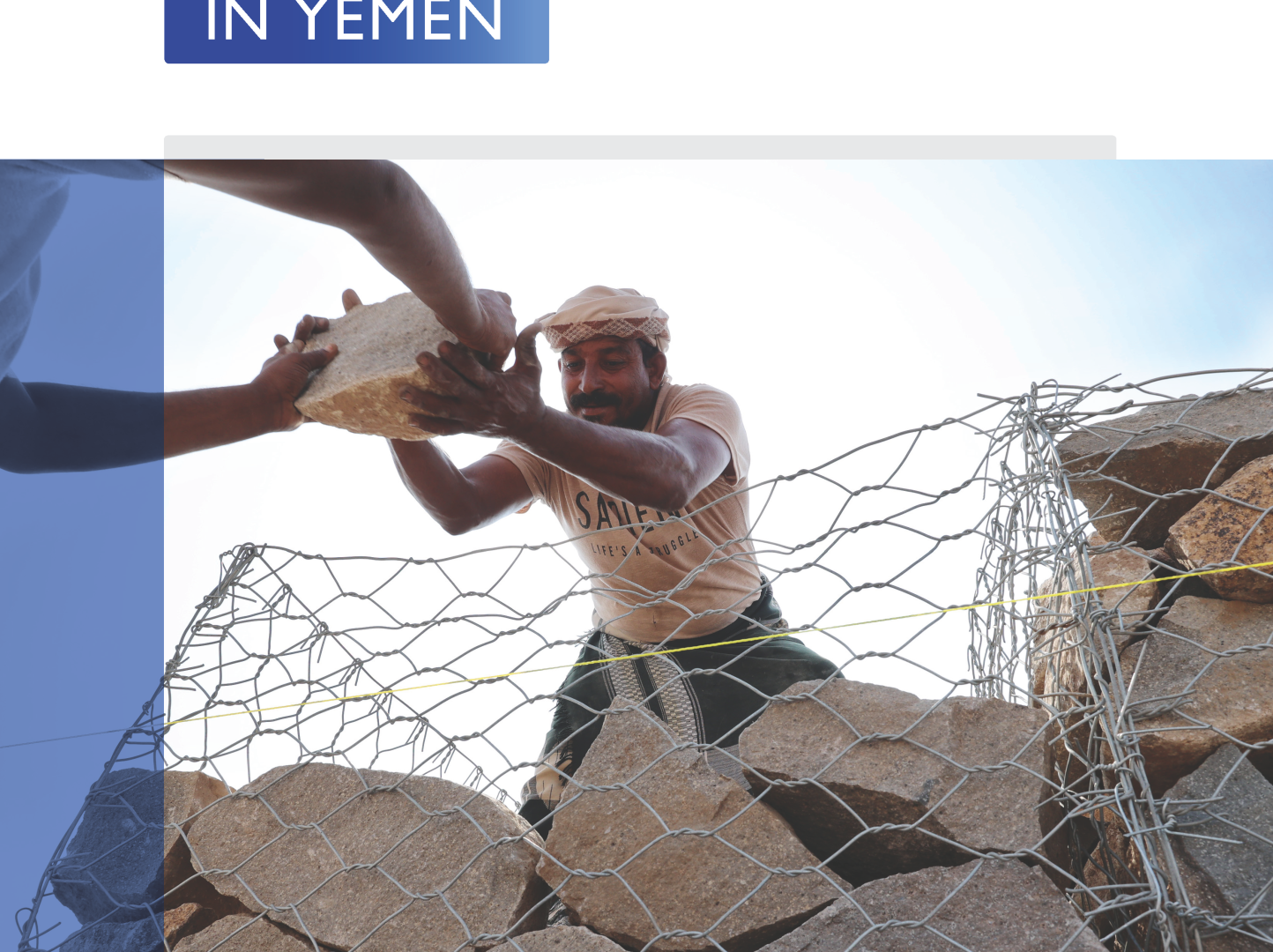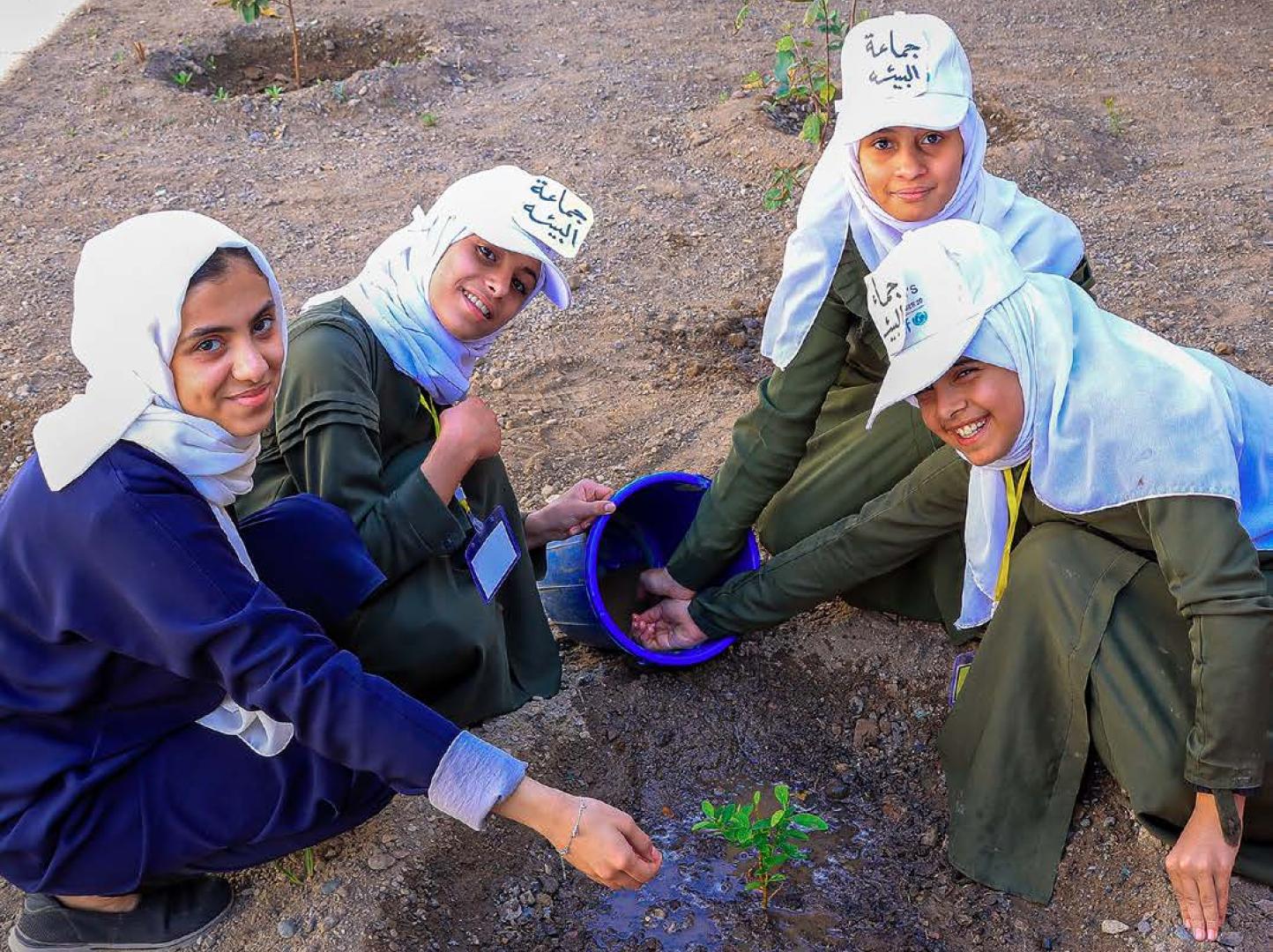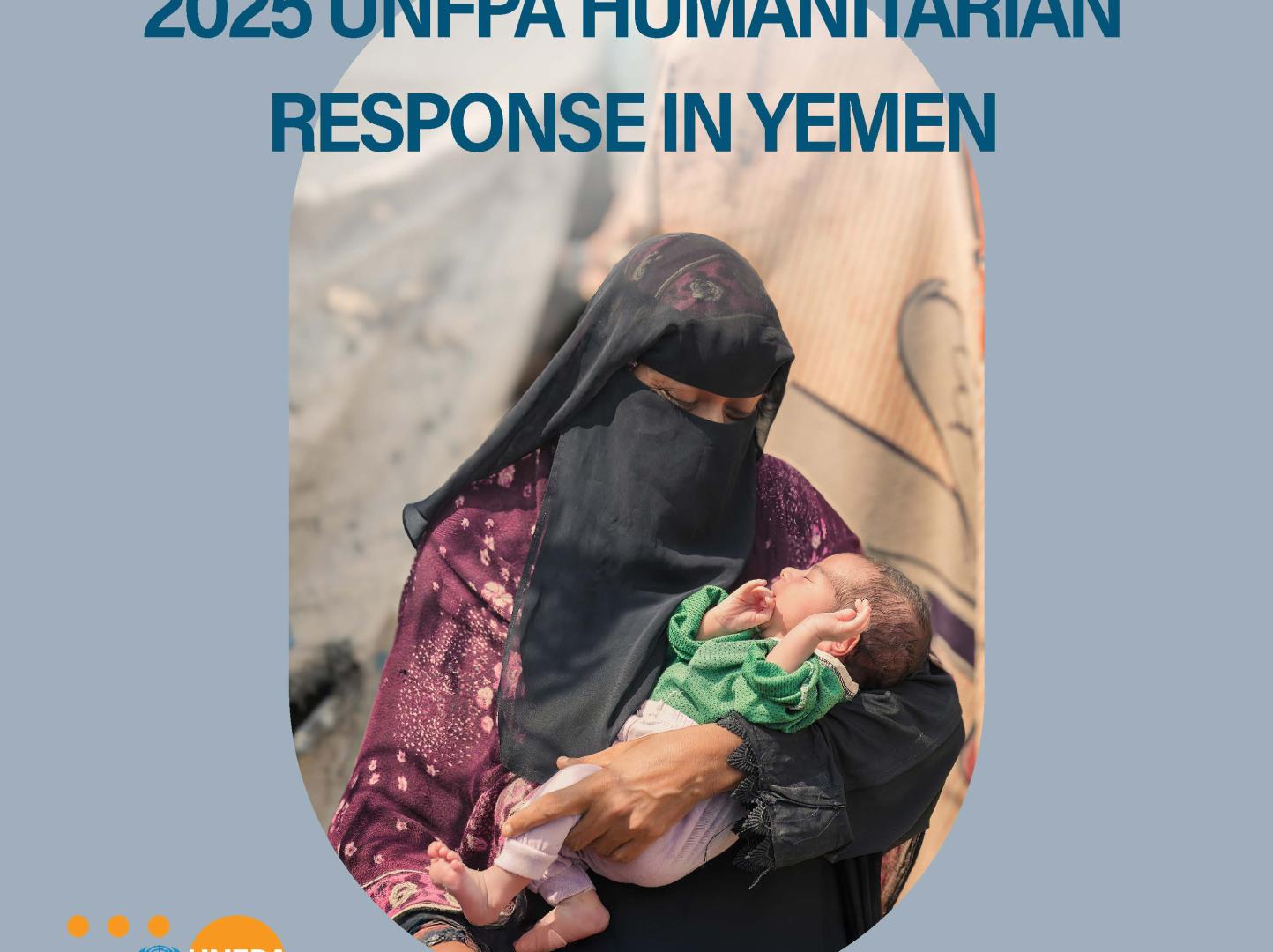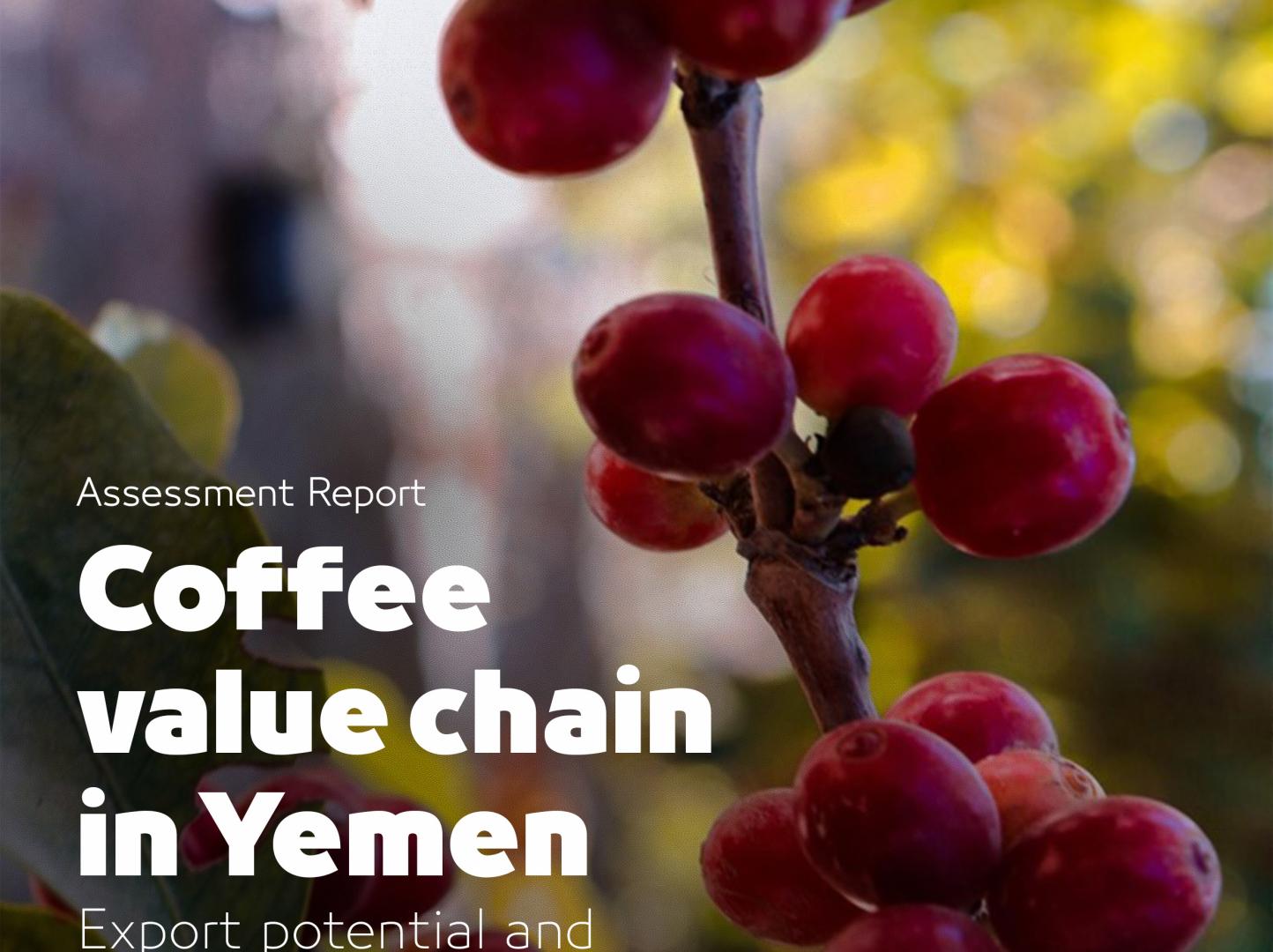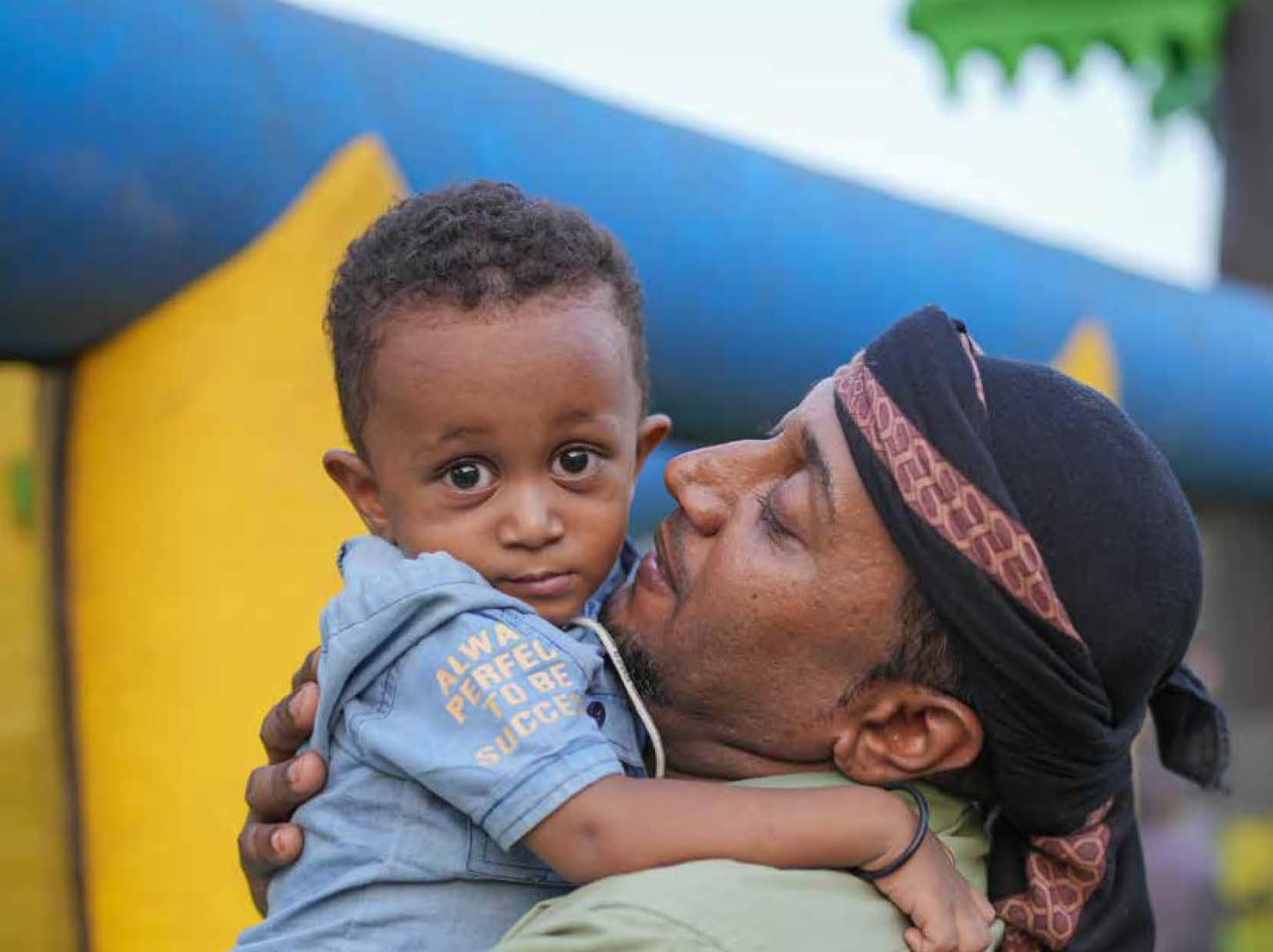Latest
Story
04 November 2025
IOM Yemen: A Return to Dignity: Restoring Health and Water Against Cholera
Learn more
Press Release
30 October 2025
FAO Yemen: Socotra Takes a Stand Against Climate Risks with FAO-Led Initiative
Learn more
Press Release
29 October 2025
FAO Yemen: FAO Marks 80 Years of Global Impact and 40 Years of Partnership in Yemen with Youth‑Led Celebrations of World Food Day
Learn more
Latest
The Sustainable Development Goals in Yemen
The Sustainable Development Goals are a global call to action to end poverty, protect the earth’s environment and climate, and ensure that people everywhere can enjoy peace and prosperity. These are the goals the UN is working on in Yemen:
Publication
28 April 2025
UN Yemen Country Results Report 2024
This report highlights the resilience of the Yemeni people and the collaborative impact of the United Nations Country Team and its partners in 2024. Despite immense challenges, significant strides were made in delivering essential development support, strengthening local capacities, and fostering pathways towards stability.Understand how the UN addressed critical needs in food security, healthcare, education, and livelihoods, while strengthening governance and promoting inclusive solutions. Discover the importance of strategic partnerships, innovative approaches, and the unwavering commitment to sustainable development goals in the Yemeni context.Download the full report to learn more about the UN's activities, achievements, and ongoing dedication to supporting Yemen's journey towards a peaceful and prosperous future.
1 of 5

Press Release
05 September 2024
IOM Yemen: IOM Appeals for USD 13.3 Million to Help Hundreds of Thousands Affected by Yemen Floods
Yemen, 5 September – In response to the severe flooding and violent windstorms affecting nearly 562,000 people in Yemen, the International Organization for Migration (IOM) has launched a USD 13.3 million appeal to deliver urgent life-saving assistance. The unprecedented weather events have compounded the humanitarian crisis in the country, leaving thousands of internally displaced persons and host communities in dire need of assistance. “Yemen is facing yet another devastating chapter in its relentless crisis, exacerbated by the intersection of conflict and extreme weather events,” said Matt Huber, IOM Yemen’s Acting Chief of Mission. “IOM teams are on the ground, working around the clock to deliver immediate relief to families affected by this catastrophe. However, the scale of the destruction is staggering, and we urgently need additional funding to ensure that the most vulnerable are not left behind. We must act immediately to prevent further loss and alleviate the suffering of those impacted.” In recent months, torrential rains and flooding have destroyed homes, displaced thousands of families, and severely damaged critical infrastructure, including health centres, schools, and roads. Across multiple governorates, including Ibb, Sana’a, Ma’rib, Al Hodeidah, and Ta’iz, thousands of people have been left without shelter, clean water, or access to basic services, and scores of lives have been tragically lost. The storms have struck as the country grapples with a cholera outbreak and escalating food insecurity, further exacerbating the vulnerability of displaced families and strained health systems. As the harsh weather conditions are expected to continue, more households are at risk of displacement and exposure to disease outbreaks due to damaged water and health infrastructure. Ma’rib Governorate has been particularly hard-hit, with strong winds since 11 August severely damaging 73 displacement sites and affecting over 21,000 households. Public services, including electricity networks, have been severely affected, aggravating the crisis in one of Yemen’s most vulnerable regions. Urgent shelter repairs and cash assistance are needed, with healthcare services and sanitation infrastructure among the most immediate priorities. Since early August, floodwaters have damaged shelters, roads, water sources, and medical facilities, leaving over 15,000 families in Al Hodeidah and 11,000 in Ta’iz in desperate need of emergency support. These rains have not only led to tragic loss of life but have also wiped out entire communities’ belongings and means of survival. In response to this crisis, IOM is targeting 350,000 people with shelter, non-food items (NFI), cash-based interventions, health, camp coordination and camp management, and water, sanitation, and hygiene interventions. Distribution of water tanks, latrine repairs, and desludging efforts are ongoing in multiple sites, while health services are being expanded, with mobile teams currently treating over 100 individuals and referring critical cases to hospitals. IOM’s efforts are further supported by emergency response committees working tirelessly to register and verify affected households, relocate displaced families, and reduce the risks of further damage. However, the resources available are insufficient to cover the vast needs, with key gaps remaining, especially in the shelter and NFI sector. With no contingency stocks for essential relief items and the situation growing more critical by the day, immediate funding is necessary to address the most pressing needs on the ground. IOM stands ready to scale up its response but requires the necessary resources to do so. With further severe weather expected in the coming weeks and funding constraints, the Organization is urgently calling on the international community to support this appeal to continue providing lifesaving aid and address the overwhelming needs of those affected. To read the full appeal, please visit this page. For more information, please contact: In Yemen: Monica Chiriac, mchiriac@iom.int In Cairo: Joe Lowry, jlowry@iom.int In Geneva: Mohammedali Abunajela, mmabunajela@iom.int
1 of 5
Press Release
04 May 2023
Statement: Remarks at the pledging event for the FSO Safer operation co-hosted by the Netherlands and the United Kingdom
First, I want echo Achim’s thank you to the United Kingdom and the Netherlands for having organized this event.
And for contributing generously.
A third element that they both deserve credit for is recognizing early on the promise of a private-sector initiative to address the Safer which the Fahem Group and SMIT Salvage proposed in mid-2021 – a time when the previous UN plan to inspect the Safer was not moving.
The initiative called for a leading maritime salvage company to transfer the oil off the Safer and replace the decaying supertanker’s capacity.
That was the basis upon which the United Nations principals asked me to lead and coordinate UN system-wide efforts on the Safer, in September 2021.
In December 2021, United Nations senior management endorsed the UN-coordinated plan and asked UNDP to implement it, contingent upon donor funding.
In February 2021, I met with the Government of Yemen in Aden, which confirmed its support for the plan.
They have remained supportive ever since – as evidenced by a $5 million pledge that they made last year.
The Sana’a authorities had been favorable to the original initiative, but insisted that it be done under UN auspices.
In March 2022, they signed a memorandum of understanding with the UN that committed them to facilitating the operation.
A commitment that they continue to honor.
The agreement was also signed by myself with the Fahem Group, which has supported engagement in Sana’a on the initiative since 2021 on a voluntary basis.
By April 2022, the UN presented a draft operational plan to begin fundraising. The original budget for phase 1 and 2 was $144 million.
As Achim said, the Netherlands pledging event in The Hague last May brought in $33 million, which was a catalyst to move us to where we are today.
But finding funds to prevent a catastrophe proved far more difficult than finding money for a disaster.
In June, we launched a public crowdfunding campaign for the operation.
That has now brought in more than $250,000. More importantly, it captured media attention that galvanized further support for the plan.
In August, we received the first pledge from a private entity. $1.2 million from the HSA Group. The International Association of Oil and Gas Producers followed with a $10 million pledge and Trafigura Foundation with $1 million.
The private sector, we learned, was concerned about its liability linked to a contribution. UNDP, in particular, led the effort to resolve those issues of concern which gives us a basis for further private sector contributions.
By September last year, the UN met the target of $75 million to start the operation.
Unfortunately, even as UNDP was gearing up to begin, the cost of suitable replacement vessels surged, chiefly due to developments related to the war in Ukraine.
More money was also needed to start the initial phase because of the necessity to purchase a replacement vessel – also linked to the war in Ukraine as suitable vessels for lease were no longer available. The budget for the emergency phase – during which the oil will be transferred – is now $129 million. Most of the funding is now required up front in phase one. Now, the second phase only requires $19 million to complete the project.
So, the budget of $148 million is just $4 million more than was presented to donors a year ago.
Prior to today’s announcements, we had raised $99.6 million from member states, the private sector and the general public.
The general public has provided donations from $1 to $5,000.
The broad coalition working to prevent the catastrophe also includes environmental groups like Greenpeace and, in Yemen, Holm Akhdar.
Every part of the United Nations is involved, including the International Maritime Organization, the UN Environmental Progamme, and the World Food Progamme. The Office for the Coordination of Humanitarian Affairs is among those that have worked on the Safer file for years and has now ensured $20 million of bridging finance. That would need to be replenished by donor funding.
I also want to recognize the United States for playing a tireless role in mobilizing resources. It is among the top five donors, together with the Netherlands, Germany, the Kingdom of Saudi Arabia and the United Kingdom.
On 9 March, UNDP’s Administrator took the bold decision to purchase the replacement vessel Nautica – before all of the operation was in place.
That is because UNDP recognized the extraordinary problem and understood that the cost of inaction is too great, as Achim outlined.
UNDP also contracted the Boskalis subsidiary SMIT Salvage, which played an enormously helpful role in developing the UN plan long before it had a contract.
With both the Nautica and the SMIT vessel Ndeavor en route to Djibouti, we expect the operation to start before the end of the month.
Therefore, I thank all donors for the generous support, and we look forward to further generous support.
But the risk of disaster remains.
I am forever thankful to the heroic skeleton crew aboard the Safer that continues to do all it can to keep that vessel together until we can organize this salvage operation.
None of us will heave a sigh of relief until the oil is transferred.
And we will all heave a final sigh of relief when the critical second phase is completed. This requires that the project is fully funded as described.
As everyone has said we are just one step away so lets take the final step.
Thank you.
1 of 5
Publication
26 October 2022
UNITED NATIONS YEMEN SUSTAINABLE DEVELOPMENT COOPERATION FRAMEWORK 2022 – 2024
EXECUTIVE SUMMARY
UN global reform has elevated the United Nations Sustainable Development Cooperation Framework (UNSDCF) to be “the most important instrument for planning and implementing UN development activities” in the country. It outlines the UN development system’s contributions to reach the Sustainable Development Goals (SDGs) in an integrated way, with a commitment to leave no one behind, uphold human rights, Gender Equality and Women’s Empowerment (GEWE), and other international standards and obligations. The UNSDCF seeks to address the humanitarian, development and peace challenges in Yemen in an environment where key public institutions are fragmented, no national strategy exists, and where there has been no national budget since 2014. The Yemen UNSDCF outlines the UN’s collective priorities and development objectives to be reached jointly in the next three years 2022-2024 as part of an ongoing and longer- term vision for resilience building and forging of a pathway to peace.
Yemen is a country in conflict. The priorities of this UNSDCF are derived from the analysis of the impacts of this ongoing crisis on the people of Yemen, and the needs and opportunities as outlined in the UN’s Common Country Analysis (CCA) conducted in 2021.
The UN has prioritized four pillars that resonate with the SDG priorities of people, peace, planet and prosperity that aim, as a matter of urgency, to improve people’s lives in Yemen and build resilience that is equitable, inclusive, people-centred, gender responsive and human rights based, through outcomes that: 1. Increase food security, improving livelihood options, and job creation 2. Preserve inclusive, effective and efficient national and local development systems strengthening 3. Drive inclusive economic structural transformation 4. Build social services, social protection, and inclusion for all
The theory of change is driven by an expectation that by 2024 the impact for all people of all ages in Yemen affected by conflict, forced displacement and living in poverty in all its dimensions will experience change in the quality of their lives. This will be possible through increased food security and nutrition, livelihood options and job creation; preserved national and local development and systems strengthening; inclusive economic structural transformation and the building of social services, social protection and inclusion for all. Food security and nutrition, and sustainable and resilient livelihoods and environmental stability will be realized through effective food production and diversified food and nutrition security; and through sustainable climate sensitive environmental management. Rights-based good governance and inclusive gender sensitive improved public services and rule of law will be possible as a result of accountable, inclusive and transparent institutions and systems, as well as the building of trusted justice systems. Increased income security and decent work for women, youth and vulnerable populations will be realised through micro and macro-economic development and job creation. Strengthened social protection and basic social support service delivery focused on support to marginalized groups, and strengthening women and youth leadership in decision making processes will be supported through the preservation of social protection and expanded and effective social assistance and basic services.
The UNSDCF prioritises the population groups in Yemen that have the highest risk of being left behind due to the impact of conflict; economic, social, geographic or political exclusion; and marginalisation. Enacting the central transformative principle of the 2030 Agenda and the SDGs, whilst challenging in the Yemen context, does provide the lens through which the UNSDCF targets the most vulnerable and prioritise Leaving No One Behind.
On the basis that some groups in Yemen bear the brunt of the conflict due to forced displacement, livelihood disruption, food insecurity, limited social safety nets, increased levels of poverty and poor-
quality housing, the CCA 2021 identifies the following population groups at the greatest risk of being left behind:
- Women and girls - 73 percent of those displaced in Yemen are women and girls, especially women of reproductive age and adolescent girls
- Children – 60 percent of those killed directly by conflict are children under five
- Youth and adolescents – an estimated 2 million school-age girls and boys are out of school as poverty, conflict, and lack of opportunities disrupt their education
- Internally displaced persons – more than 4 million IDPs with 172,000 newly displaced in 2020 and almost 160,000 in 2021
- Refugees, asylum seekers and migrants – Yemen hosts approximately 138,000 migrants and 140,000 refugees and asylum seekers
- Persons with disabilities – 4.5 million Yemenis have at least one disability
- Ethnic and religious minorities – It is estimated that Muhamasheen represent 10 percent of the population living in marginalised conditions
The UNSDCF is comprised of four chapters. Chapter One: explores Yemen’s progress towards the 2030 Agenda through a detailed analysis of the country context drawing on the 2021 CCA. Chapter Two: presents the theory of change generally and per outcome area. Chapter Three: outlines the UNSDCF’s implementation plan focused on the management structure, resources, links to country programming instruments and Yemen’s Business Operations Strategy. Chapter Four: highlights the process for CCA updates, Monitoring and Evaluation and Learning. The Results Framework presents the outcomes and key performance indicators for monitoring agreed targets utilizing verifiable data sets. Two annexes capture the legal basis for all UN entities engaged in the UNSDCF and the mandatory commitments to Harmonised Approaches to Cash Transfers (HACT)1.
The UNSDCF represents the UN’s understanding that continued engagement in Yemen requires an operational architecture under-pinned by the Business Operations Strategy (BOS) and an integrated set of achievable programming priorities. These two strategic approaches of the UN system strengthen and make more inclusive the country’s national and local governance structures, and mainstream the required responses to the economic and health consequences of COVID-19. They tackle food insecurity and nutrition as a matter of priority and integrate the promotion and advancement of gender equality and women’s and girl’s empowerment.
UN global reform has elevated the United Nations Sustainable Development Cooperation Framework (UNSDCF) to be “the most important instrument for planning and implementing UN development activities” in the country. It outlines the UN development system’s contributions to reach the Sustainable Development Goals (SDGs) in an integrated way, with a commitment to leave no one behind, uphold human rights, Gender Equality and Women’s Empowerment (GEWE), and other international standards and obligations. The UNSDCF seeks to address the humanitarian, development and peace challenges in Yemen in an environment where key public institutions are fragmented, no national strategy exists, and where there has been no national budget since 2014. The Yemen UNSDCF outlines the UN’s collective priorities and development objectives to be reached jointly in the next three years 2022-2024 as part of an ongoing and longer- term vision for resilience building and forging of a pathway to peace.
Yemen is a country in conflict. The priorities of this UNSDCF are derived from the analysis of the impacts of this ongoing crisis on the people of Yemen, and the needs and opportunities as outlined in the UN’s Common Country Analysis (CCA) conducted in 2021.
The UN has prioritized four pillars that resonate with the SDG priorities of people, peace, planet and prosperity that aim, as a matter of urgency, to improve people’s lives in Yemen and build resilience that is equitable, inclusive, people-centred, gender responsive and human rights based, through outcomes that: 1. Increase food security, improving livelihood options, and job creation 2. Preserve inclusive, effective and efficient national and local development systems strengthening 3. Drive inclusive economic structural transformation 4. Build social services, social protection, and inclusion for all
The theory of change is driven by an expectation that by 2024 the impact for all people of all ages in Yemen affected by conflict, forced displacement and living in poverty in all its dimensions will experience change in the quality of their lives. This will be possible through increased food security and nutrition, livelihood options and job creation; preserved national and local development and systems strengthening; inclusive economic structural transformation and the building of social services, social protection and inclusion for all. Food security and nutrition, and sustainable and resilient livelihoods and environmental stability will be realized through effective food production and diversified food and nutrition security; and through sustainable climate sensitive environmental management. Rights-based good governance and inclusive gender sensitive improved public services and rule of law will be possible as a result of accountable, inclusive and transparent institutions and systems, as well as the building of trusted justice systems. Increased income security and decent work for women, youth and vulnerable populations will be realised through micro and macro-economic development and job creation. Strengthened social protection and basic social support service delivery focused on support to marginalized groups, and strengthening women and youth leadership in decision making processes will be supported through the preservation of social protection and expanded and effective social assistance and basic services.
The UNSDCF prioritises the population groups in Yemen that have the highest risk of being left behind due to the impact of conflict; economic, social, geographic or political exclusion; and marginalisation. Enacting the central transformative principle of the 2030 Agenda and the SDGs, whilst challenging in the Yemen context, does provide the lens through which the UNSDCF targets the most vulnerable and prioritise Leaving No One Behind.
On the basis that some groups in Yemen bear the brunt of the conflict due to forced displacement, livelihood disruption, food insecurity, limited social safety nets, increased levels of poverty and poor-
quality housing, the CCA 2021 identifies the following population groups at the greatest risk of being left behind:
- Women and girls - 73 percent of those displaced in Yemen are women and girls, especially women of reproductive age and adolescent girls
- Children – 60 percent of those killed directly by conflict are children under five
- Youth and adolescents – an estimated 2 million school-age girls and boys are out of school as poverty, conflict, and lack of opportunities disrupt their education
- Internally displaced persons – more than 4 million IDPs with 172,000 newly displaced in 2020 and almost 160,000 in 2021
- Refugees, asylum seekers and migrants – Yemen hosts approximately 138,000 migrants and 140,000 refugees and asylum seekers
- Persons with disabilities – 4.5 million Yemenis have at least one disability
- Ethnic and religious minorities – It is estimated that Muhamasheen represent 10 percent of the population living in marginalised conditions
The UNSDCF is comprised of four chapters. Chapter One: explores Yemen’s progress towards the 2030 Agenda through a detailed analysis of the country context drawing on the 2021 CCA. Chapter Two: presents the theory of change generally and per outcome area. Chapter Three: outlines the UNSDCF’s implementation plan focused on the management structure, resources, links to country programming instruments and Yemen’s Business Operations Strategy. Chapter Four: highlights the process for CCA updates, Monitoring and Evaluation and Learning. The Results Framework presents the outcomes and key performance indicators for monitoring agreed targets utilizing verifiable data sets. Two annexes capture the legal basis for all UN entities engaged in the UNSDCF and the mandatory commitments to Harmonised Approaches to Cash Transfers (HACT)1.
The UNSDCF represents the UN’s understanding that continued engagement in Yemen requires an operational architecture under-pinned by the Business Operations Strategy (BOS) and an integrated set of achievable programming priorities. These two strategic approaches of the UN system strengthen and make more inclusive the country’s national and local governance structures, and mainstream the required responses to the economic and health consequences of COVID-19. They tackle food insecurity and nutrition as a matter of priority and integrate the promotion and advancement of gender equality and women’s and girl’s empowerment.
1 of 5
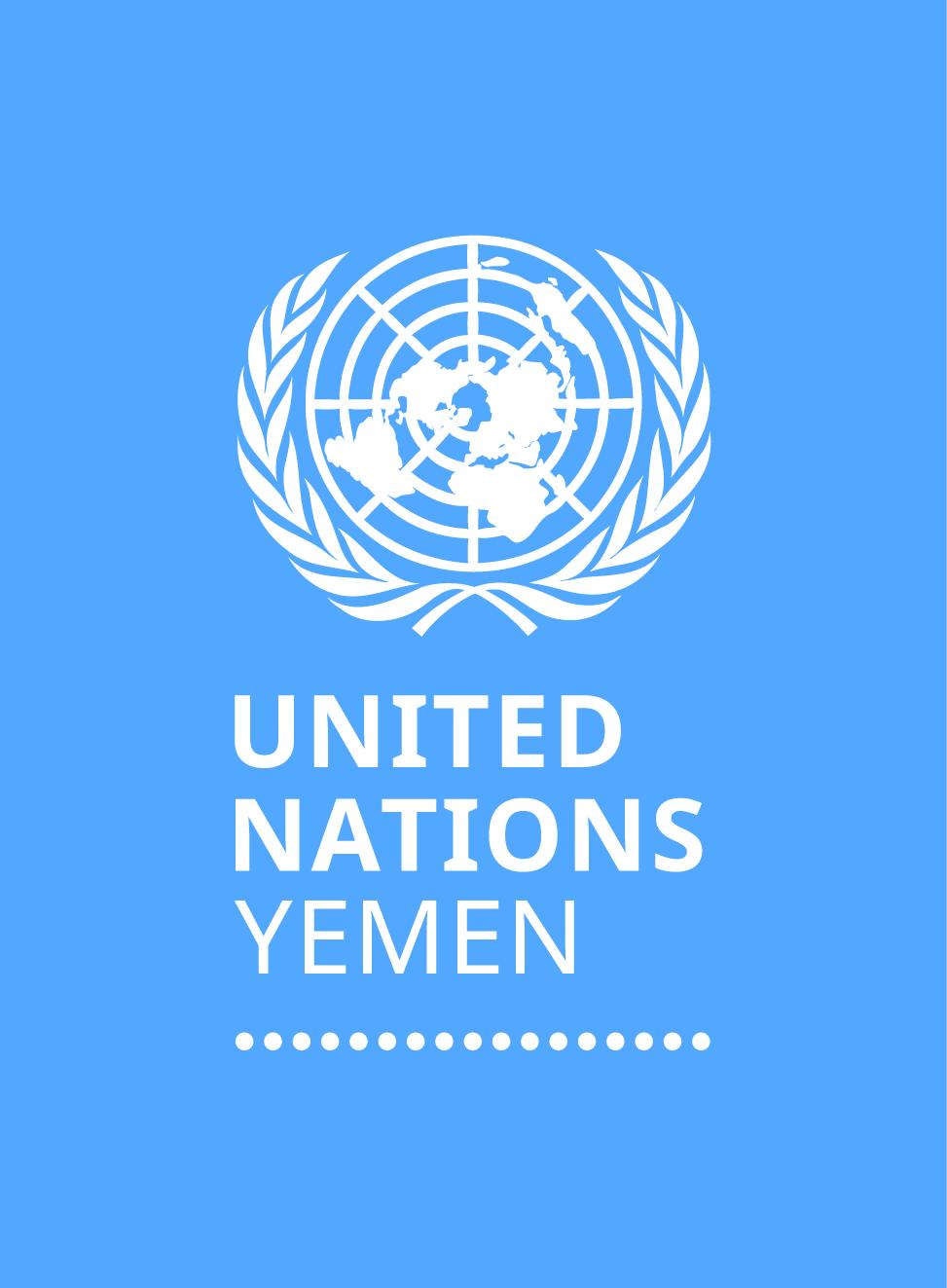
Press Release
15 August 2024
UNFPA/UNICEF Yemen: Life-saving aid critical as torrential rain sparks deadly floods across Yemen
Sana’a, 15 August 2024As relentless rain and catastrophic flooding in Yemen continue to exacerbate the suffering of families grappling with the impacts of poverty, hunger and protracted conflict, UNFPA, the United Nations Population Fund and UNICEF, the United Nations Children’s Fund, are delivering life-saving aid to some of the most vulnerable individuals through the Rapid Response Mechanism (RRM). With torrential rains forecast to continue into September, US$4.9 million is urgently needed to scale up the emergency response. Exceptionally heavy seasonal rains have caused flash floods in Yemen which are wreaking havoc in different parts of the country – the governorates of Al Hodeidah, Hajjah, Sa’ada, and Taizz are among the hardest-hit. Homes, shelters, and belongings have been swept away. Since early August, more than 180,000 people have been affected – over 50,000 people have been displaced in Al Hodeidah alone – a figure that is likely to rise in the coming days. Within 72 hours of the floods, over 80,000 people in flood-affected governorates had received emergency relief through the RRM, including ready to eat food rations, hygiene items, and women’s sanitary products. These items offer some immediate relief from the hardships caused by these catastrophic events. “The devastating floods have increased people’s needs, which are tremendous,” said Enshrah Ahmed, UNFPA Representative to Yemen. “Our RRM teams are working round the clock to provide immediate relief to affected families, but with rising needs and severe weather conditions forecasted, the coming weeks and months will be critical to ensuring affected families can pick themselves up and, at the very least, recover their lives.” In 2024, an estimated 82 percent of people supported through the RRM have been severely affected or displaced by climate-related shocks. As a result of the unseasonal levels of rain, the RRM cluster has had to spring into action, overstretching RRM teams, and depleting available supplies and resources. As needs continue to rise, RRM teams are struggling to reach affected families due to damaged roads, the erosion of landmines and unexploded ordnance from frontline to civilian areas. Items included in the RRM package are also in short supply. “The situation in the flooded areas is devastating. UNICEF and partners are on the ground providing urgently needed support to those impacted. The role of the Rapid Response Teams is critical in times of distress such as this one,” said Peter Hawkins, UNICEF Representative to Yemen.The RRM in Yemen was established in 2018 to provide a minimum package of immediate, critical life-saving assistance during human-made or natural disasters to newly displaced persons, and people in displacement sites or hard-to-reach areas, until the first line cluster response kicks in. The RRM ensures the distribution of immediate, ready-to-eat rations, basic hygiene kits provided by UNICEF, and women’s sanitary items provided by UNFPA, within 72 hours of a displacement alert. *** For more information, please contact UNFPA Taha Yaseen: Tel. +967 712 224090; yaseen@unfpa.org Lankani Sikurajapathy: Tel. +94773411614; sikurajapathy@unfpa.org UNICEF Kamal Al-Wazizah: Tel. +967 712 223 06; kalwazizah@unicef.org
1 of 5
Story
04 November 2025
IOM Yemen: A Return to Dignity: Restoring Health and Water Against Cholera
By:Abeer Alhasani | Communication and Translation AssistantAyoub Al-Ahmadi | Senior Translation AssistantWest Coast, Yemen Naima felt as though death had stepped into her home, watching helplessly as her five children grew weaker by the hour, their tiny bodies trembling under the grip of illness. For a few nights, she lay sleepless, her heart clenched by the fearful thought of losing all her children at once. When cholera first swept through the displacement camp where she lived last year, the outbreak struck with brutal force. All five of Naima’s children were affected, leaving her terrified and overwhelmed. The fear and despair that consumed her were unbearable, and she recalls those days as the darkest of her life. Like many other displaced families in Hays, Naima lives in a fragile shelter made of palm branches and plastic sheets on Yemen’s west coast. Life there is a daily struggle — clean water and safe sanitation are scarce, and each day begins with worries about securing the basics to survive and ends in uncertainty. Yemen has faced waves of cholera since the beginning of the conflict, but the resurgence in 2024 hit displaced communities the hardest. The disease spread rapidly through overcrowded shelters lacking safe water and hygiene facilities. Within weeks, hundreds of suspected cases were reported, mostly among children, women, and the elderly. For Naima, the deadly outbreak felt inescapable. With no latrine in her tiny shelter and with a shallow, contaminated well nearby as the only water source, avoiding the epidemic seemed impossible. “All the families in this sector depend on this well,” Naima recounts. “Once we saw a snake in the well, and we had to wait for a couple of days before drinking from it again.” When Naima’s children fell ill, she had nowhere to turn for help. Local health facilities were either nonfunctional or too far to reach on foot, and she simply couldn’t afford the cost of transport. Then, a glimmer of hope appeared when neighbors advised her to visit the Diarrhea Treatment Centre (DTC) supported by the International Organization for Migration (IOM). Established in Hays in 2024, the DTC has become a critical lifeline for thousands of displaced people and host community members, providing free treatment — primarily rehydration and urgent care. Naima still remembers carrying her youngest child, a six-month-old baby, to the DTC. The baby’s body was frail, her eyes hollow. “I thought my daughter wouldn’t survive the night,” Naima recalls softly. “But the doctors rushed to give her the care she needed. Slowly, she opened her eyes again. That was the moment hope returned and fear finally faded.” At the DTC, IOM’s medical teams admitted all of Naima’s children, ensuring each received fluids, antibiotics when necessary, and round-the-clock monitoring. Within a couple of days, their conditions began to improve. “I will never forget the kindness of the nurses,” Naima says. “They treated my children like their own when I broke down.” To prevent further spread of the disease, the DTC also conducts awareness-raising sessions among affected communities and distributes hygiene kits and water purification tablets. In addition to treatment and awareness efforts, IOM supported a cholera vaccination campaign in Hays to enforce the protection of displaced families alongside host communities. Mobile Health teams moved through camps and villages, ensuring that people received oral cholera vaccine. For many, they felt a sense of protection against the disease and the ability to stay safe.IOM’s health and hygiene teams work tirelessly to sensitize families about simple, life-saving hygiene practices and demonstrate how to prepare oral rehydration solution at home. Beyond cholera, a larger crisis still loomed — the persistent shortage of safe water. For years, families in Hays barely survived, with no steady income to buy clean water. Their only option was to rely on shallow, unprotected wells. The water often turned salty and unsafe, fueling new outbreaks instead of sustaining life. “We used water directly from the well. I didn’t know it was risky for my children,” Naima admits. “The awareness sessions helped me teach other women in the village about hygiene and prevention.” Women and children often walked kilometers under the scorching sun and through unsafe areas just to fetch water. Exhaustion, insecurity, and fear accompanied every step. Children suffered constant diarrhea, families grew weaker, and the demand for healthcare increased. To address this need, IOM’s Water, Sanitation, and Hygiene (WASH) team conducted studies to find solutions to the area’s rough and saline water conditions. The team eventually drilled new boreholes, laid transmission lines, and installed pump and solar systems in Hays connected to safe water sources. For the first time in over 15 years of conflict, families could access reliable, clean water near their homes. It became more than just a tank — it was a symbol of restored safety and dignity. For families like Naima’s, the tower changed everything. She no longer has to choose between unsafe water and risky journeys. Dr. Aws, a health worker at IOM’s DTC in Hays, explained that access to safe water is just as important as medicine in protecting families. “Clean water and treatment save lives, but prevention helps stop the disease from spreading in the first place,” he said. Despite the decline in cholera cases following improved access to safe water, challenges remain immense. The DTC in Hays is overwhelmed, treating hundreds of patients each month — mostly children. Supplies often run low during epidemic waves, and health workers endure long hours under difficult conditions. “The need is far greater than the resources we have. We sometimes receive the same patient more than once and still struggle to meet the growing demand,” Dr. Aws said. Yemen’s health system, already fragile for years, continues to struggle. Many health facilities in Al Hodeidah governorate are closed or barely functional, leaving displaced families with few options, making the DTC the only available lifeline for many. For Naima, the experience shook her life but also strengthened her determination. “Now I know how to protect my children,” she says. “I also tell others in the camp how to prevent the spread of disease because I don’t want anyone to go through what I did.” IOM’s broader cholera response extends to multiple governorates through the support to health facilities, ORPs, and mobile medical teams providing care in hard-to-reach and rural areas. The cholera outbreak in Yemen remains far from over. More families like Naima’s are still at risk and urgently need support in water, sanitation, and healthcare to stay protected. “I am just one of many,” Naima concludes. “If my children survived, I believe others can too — as long as the support continues.” As Yemen continues to grapple with one of the world’s worst humanitarian crises, the cholera and WASH responses highlight the urgent need for sustained support. IOM’s cholera response in Yemen, including the Diarrhea Treatment Centre (DTC), is supported by the Central Emergency Response Fund (CERF), and the water tower along with the system expansion in Hays was made possible through the generous support of the German Government through KfW Development Bank and EU Humanitarian Aid (ECHO).
1 of 5

Story
27 October 2025
In Yemen, WHO-supported frontliners deliver hope at the start of life
Aden, Yemen In the heart of Aden, where conflict, fragility and a crumbling health system converge, 2 health care heroes – Ashwaq Saeed and Hind Hadi – are quietly rewriting the story of maternal and newborn survival. Each day, at Al-Sadaqa Teaching Hospital, they struggle against the odds to give every newborn the best possible start in life.Ashwaq Saeed, Supervisor of the Midwifery Department and Head of the Gynaecology and Obstetrics Ward, started at Al-Sadaqa as a volunteer. Her role soon evolved into a life-defining mission.“Midwifery isn’t just about delivering babies,” says Ashwaq. “It’s about being present at the most vulnerable and beautiful moment in a family’s life.”In a health system where only 50% of facilities are fully functional and maternal and neonatal mortality rates are alarmingly high, Ashwaq’s passion fills a critical gap. She and her team face a near constant scarcity of supplies, workforce shortages and low community awareness, yet she finds ingenious ways to adapt. “We store surplus supplies for emergencies and we educate mothers whenever we can,” says Ashwaq. But to improve outcomes, she adds, more investment in training and equipment is urgently needed.In the adjacent neonatal unit Hind Hadi, a nurse with over 12 years of experience, manages the care of premature and critically ill newborns. “We receive babies not just from the emergency department but from across other governorates,” she says. “Sometimes we simply don’t have enough beds.”Her unit battles overcrowding daily, yet her commitment never wavers. “The joy in a mother’s eyes when her child recovers, it’s indescribable. That’s when I know our work truly matters,”Ashwaq and Hind’s courage and commitment may fill some of the gaps, but without systemic change, training and resources, these health care workers are being stretched beyond their limits. Frontline dedication alone is not enough.Recognizing these challenges, the World Health Organization (WHO) has taken a decisive role in strengthening Yemen’s maternal and newborn care through the introduction of Early Essential Newborn Care (EENC), a package of evidence-based lifesaving interventions during delivery and the early newborn period designed to prevent the most common causes of newborn mortality – hypothermia, asphyxia and infections – through low-cost, high-impact practices like immediate skin-to-skin contact, delayed cord clamping and early initiation of breastfeeding.Under the leadership of the Ministry of Public Health and Population, WHO conducted Yemen’s first EENC coaching for facilitators in June 2022, beginning with Al-Sadaqa Hospital.Baseline assessments prior to the EENC coaching revealed alarming shortcomings in current practice. Many newborns were being separated from their mothers immediately after birth. Skin-to-skin contact and thorough drying were rarely performed. Harmful routines such as early cord clamping and routine suctioning were widespread.The WHO-supported coaching proved transformative. Staff knowledge scores for managing breathing babies jumped from 0% to 96%, and for non-breathing babies from 36% to 93%. A total of 28 facilitators and staff from 4 hospitals were trained, including Ashwaq and Hind. Both now serve as EENC champions within their departments.Hind, who had been managing her unit’s overwhelming caseload with limited equipment, now has the technical tools to respond faster and more effectively to emergencies. Ashwaq, empowered by new techniques and protocols, is pushing for changes in hospital policies and advocating for increased recognition of midwives in her community.The transformation is human as well as technical. EENC has reinvigorated cooperation between paediatricians, obstetricians and nurses. It has restored a sense of agency to health workers that had long been overshadowed by systemic failure. Sustaining this progress requires more than one-off trainings. As WHO continues to scale up EENC in other hospitals, including Al Sha’ab, Al Razi and Ibn Khaldoun, consistent supplies of coaching materials and medical equipment, as well as policy backing, are vital. Support is also needed to address infrastructure challenges such as the absence of proper resuscitation spaces near delivery rooms, and to ensure mothers have clothing that allows skin-to-skin contact.Today, it is frontline champions like Ashwaq and Hind who carry WHO’s vision forward. But they cannot do it alone.Yemen’s health system is still under-resourced, leaving newborn lives at risk. Sustained donor support is urgently needed to expand lifesaving interventions like EENC across the country. By investing in these local heroes and the systems that support them we not only save lives – we restore dignity and hope to families across Yemen.Every child deserves the chance to take their first breath in safe hands.
1 of 5

Story
15 October 2025
UNDP Yemen: When Water is Hard to Reach and Climate Change Intensifies
Yemen is one of the most water-scarce countries in the world. The per capita share of renewable water resources is only around 80 cubic meters per year, far below the global threshold of 1,000 cubic meters that defines water stress. With no permanent rivers, Yemen depends heavily on rainfall and rapidly depleting groundwater.Rural communities are disproportionately affected by this water crisis. Over 14.5 million people in Yemen lack access to safe drinking water and sanitation services, the majority of whom live in rural and hard-to-reach areas. In villages like Saboon in Taiz, where Rana lives, people still fetch water from traditional wells, often walking long distances under harsh conditions. Without reliable infrastructure, these communities face recurring crop losses, land degradation, and limited economic opportunities. These factors push them further into poverty and heightened vulnerability. Women and girls bear the brunt of water scarcity, as they are typically responsible for collecting water. In some rural parts of Yemen, women and girls walk for hours each way to fetch water. This time-consuming task not only affects their health and safety but also contributes to high school dropout rates among girls and restricts women’s ability to participate in education, economic activities, or community decision-making. As Rana notes, “Water scarcity heavily affects us women. We walk long distances to collect water from old wells, which requires significant effort and time.” The burden of collecting water is physical, social, and economic - reinforcing cycles of inequality and vulnerability. Recognising this, the Integrated Water Resources Management to Enhance Resilience of Agriculture (IWRM-ERA) and Food Security Project, funded by the German Federal Ministry for Economic Cooperation and Development (BMZ) through KfW, works to ensure the meaningful inclusion of women across all its activities. "As women, we participate in everything. From identifying community needs to planning and attending activities," shares Rana. “Conflicts over water access sometimes occur, especially when sources are scarce,” explains Rana. Indeed, research has indicated that 70–80 percent of all rural conflicts in Yemen are related to water. This high prevalence of water-related disputes underscores the vulnerability of communities already grappling with limited and unreliable water sources. Displacement and shifting rainfall patterns are all adding pressure on Yemen’s water supply networks, exacerbating Yemen’s decade-long conflict. Food security in Yemen is also deeply intertwined with water access. As of 2024, over 17 million Yemenis face acute food insecurity according to recent UN reports. This number rises during periods of drought or conflict. Poor water access limits what and how much farmers can grow. Crops fail more frequently, and livestock suffer, leading to lower food availability and higher prices. The reliance on inefficient irrigation systems and water-thirsty crops like qat further compounds the problem. Farmers like Rana are seeing progress from floodwater harvesting and small-scale infrastructure improvements, but the country urgently needs sustainable water solutions to stabilize food production. “UNDP’s IWRM-ERA Project implemented several interventions in our area, such as constructing retaining walls and improving water access. These walls help control floodwaters, preventing them from damaging farmlands. They also help us collect rainwater, which we use to irrigate trees and crops. This had led to noticeable growth in our trees and increased crop production,” explains Rana.Poverty is both a cause and a consequence of Yemen’s water crisis. Around 80% of Yemen’s population lives below the poverty line, and most of them depend on agriculture and natural resources for survival. In water-scarce regions, families face impossible choices between buying food, accessing water, or sending children to school. The IWRM-ERA Project provides critical support to these communities by constructing water infrastructure, training farmers - with extra efforts to reach women farmers, and introducing climate-resilient practices. “Since the land is now protected and water is available, agricultural yields have improved, and farmers' income has increased. Families are benefiting both nutritionally and economically by selling the surplus produce,” says Rana.These interventions offer a path forward, but long-term change in Yemen requires sustained investment in water governance, women’s empowerment, and rural development.
1 of 5

Story
13 October 2025
FAO Yemen: Enhancing Livestock Resilience in Yemen: A Comprehensive Approach to Climate and Conflict Challenges
Yemen's Rural Communities Face Unprecedented ChallengesBetween 2020 and 2024, the Food and Agriculture Organization of the United Nations (FAO) implemented a multi-year initiative to strengthen the resilience of livestock-dependent communities across seven governorates in Yemen: Hajjah, Al-Hudaydah, Al-Mahwit, Saada, Lahj, Taiz, and Abyan.In a country where conflict, economic collapse, and climate shocks have combined to create one of the world's worst humanitarian crises, this intervention focused on protecting livestock, which serve as the cornerstone of rural livelihoods and food security for millions of Yemenis.Livestock Under ThreatExtreme heat, recurrent droughts, and flash floods have devastated grazing lands, depleted water sources, and reduced feed availability. Outbreaks of significant animal diseases, such as Peste des Petits Ruminants (PPR) and Sheep and Goat Pox (SGP), have further threatened livestock productivity and household incomes. Additionally, ongoing conflict has disrupted markets and veterinary services, leaving smallholder farmers without crucial support.In this context, FAO's intervention provided both immediate relief and long-term solutions to protect livestock health, enhance productivity, and build community resilience. A Comprehensive Approach to Climate-Resilient Livestock ManagementThe initiative followed a multi-phase, evidence-based methodology that combined humanitarian assistance with long-term climate adaptation strategies. The stages included:Assessment and Planning: FAO conducted in-depth needs assessments in collaboration with the Ministry of Agriculture, Irrigation and Fish Wealth (MAIF), the Agriculture Research and Extension Authority (AREA), local NGOs, and communities. The assessments identified climate risks, mapped vulnerabilities, and recommended adaptation measures in areas dependent on livestock.Capacity Building:Community Animal Health Workers (CAHWs) were trained to diagnose, prevent, and report animal diseases. Farmers and pastoralists received training on climate-smart agriculture (CSA) and sustainable rangeland management.Livestock Health and Nutrition:FAO led mass vaccination campaigns against PPR and SGP, and treatment against internal and external worms, distributed emergency feed, and promoted the cultivation of climate-resilient fodder crops.Water Management:Water harvesting structures were constructed to mitigate the impacts of drought and improve access to water for livestock.Women and Youth Empowerment:Training programs supported women and youth in dairy processing, cheese making, poultry production, and cooperative formation, creating new sources of income and enhancing gender inclusion.Monitoring and Accountability:Through third-party monitoring, FAO tracked progress on livestock health, productivity, and household resilience. A Grievance Redress Mechanism (GRM) ensures that community feedback informs project adaptations. From Anticipation to TransformationThe project integrated climate action across all stages of resilience building:Anticipation and Prevention: Climate risk mapping and early warning systems informed vaccination and feed distribution schedules.Shock Absorption: Vaccination, deworming, water harvesting, and fodder distribution helped households withstand climate shocks.Adaptation: Sustainable rangeland management, drought-tolerant breeds, and income diversification reduced vulnerability.Recovery: Emergency feed, veterinary kits, and mobile clinics supported recovery in crisis-affected areas.Transformation: FAO collaborated with national institutions to integrate livestock resilience into Yemen's Animal Health and Development Strategy, thus promoting long-term adaptation to climate change and conflict. Key Results and ImpactFAO's work yielded measurable improvements in food security, livelihoods, and environmental sustainability:Over 5 million livestock were vaccinated and treated, reducing disease outbreaks at a cost of about USD 0.50 per animal, saving the live of a goat or sheep worth USD 100. Household milk production increased by 25%, while income from livestock sales rose by 15%.Rangeland rehabilitation improved vegetative cover by up to 15% in targeted areas.Over 6,000 women were trained in livestock management and small-scale agribusiness, gaining both income and decision-making power.Strengthened social cohesion between internally displaced persons (IDPs) and host communities, reduced tensions linked to resource competition.Scaling Up SuccessFAO's climate-resilient livestock model is now being scaled across other regions in Yemen. This approach combines low-cost, locally adapted technologies with community-based service delivery, making it especially effective in fragile contexts with limited formal veterinary systems.Sustainability depends on continued collaboration with local authorities, inclusive participation, especially that of women, and flexible funding that bridges humanitarian responses and long-term development. By integrating climate risk management, gender inclusion, and community engagement, the initiative aims to secure a resilient future for Yemen's livestock-dependent communities.
1 of 5

Story
07 October 2025
WHO Yemen: Every Door Matters: Yemen’s fight for a polio-free future
Aden, Yemen In the heart of Aden’s Crater district, two young sisters — Nehal, just 11 months old, and Nuha, 3 years old, received their polio vaccines as part of Yemen’s nationwide campaign to protect every child. Their mother welcomed the health worker with quiet relief. In a world full of uncertainty, safeguarding her daughters felt like a promise fulfilled.Across Yemen, families are opening their doors in a powerful act of hope. On the other side stands a health worker, ready to deliver two drops that could change a child’s life forever.For the health worker – Nagwa Ali – who knocked on Nehal and Nuha’s door, each child she vaccinates is part of a larger story. “Every door we knock on brings Yemen closer to a day without polio,” she says. Conflict, barriers to access and misinformation make it hard to reach every child but Yemen’s health workers, with the Ministry of Public Health and Population (MoPHP) and the World Health Organization (WHO) at their side, are finding ways to overcome the challenges. They travel far, reassure worried parents, and persist through every challenge.“No child should suffer a disease we know how to prevent. Together, we can make polio history,” says WHO Representative in Yemen Dr Syed Jaffer Hussain.Each time a child receive the vaccine Yemen moves closer to freedom from polio. Each knock on a door, each gentle conversation, each purple mark on a child’s finger is a step toward a healthier future. The vital support of the Global Polio Eradication Initiative (GPEI) makes it possible to deliver vaccines to the most vulnerable communities of Yemen, keep cold-chain systems running despite difficult conditions, train and equip thousands of health workers and sustain the tireless campaigns that keep hope alive.With GPEI’s commitment and the unwavering determination of MoPHP, WHO and Yemen’s frontline vaccinators, the vision of a country free from polio is no longer distant. It is within reach for every child.
1 of 5

Press Release
30 October 2025
FAO Yemen: Socotra Takes a Stand Against Climate Risks with FAO-Led Initiative
Socotra, October 2025 The Food and Agriculture Organization of the United Nations (FAO), in collaboration with the Governorate of Socotra, the Environment Protection Authority (EPA), and key local and national partners, has launched a community-based climate change awareness campaign in Hadibu. The initiative aims to enhance public understanding and local engagement on climate-related risks affecting the Socotra Archipelago.Held under the theme “Together Toward a Green and Sustainable Future,” the campaign brought together more than 60 participants, including young people, women, civil society organizations, media professionals, and decision-makers. The event was conducted within the framework of the FAO-led project Resilient and Sustainable Livelihoods for Rural Yemen, funded by the Global Environment Facility (GEF) and the Government of Yemen.Addressing a Global Challenge at the Local LevelRecognized as a UNESCO World Heritage site, the Socotra Archipelago is renowned for its unique biodiversity. However, it faces mounting threats from climate change, including intensified cyclones and extreme weather events, which endanger both ecosystems and livelihoods.The campaign featured interactive sessions on:The causes and global consequences of climate change;Climate adaptation and mitigation strategies;Socotra’s environmental assets and vulnerabilities;FAO-supported measures to build climate-resilient livelihoods.This initiative underscores the importance of informed community action in safeguarding natural resources and promoting environmental stewardship.Empowering Communities for Lasting Impact“The biodiversity of Socotra is of global significance. Strengthening local awareness and capacity is essential to building resilience and protecting these fragile ecosystems,” said Abdulwahab Ali, FAO Programme Assistant in the Socotra Archipelago.Participants put forward a series of community-driven recommendations, including establishing early warning systems, promoting nature-based solutions, and enhancing multi-stakeholder collaboration.About the ProjectThe campaign is part of a broader effort to strengthen climate resilience and sustainable natural resource management across Yemen. The project is implemented by FAO and supported by the GEF agency for the first phase and will subsequently be led by the Environment Protection Authority. A Strong cooperation from the Governor’s Office, local agricultural and fisheries offices, national NGOs and national media has contributed to the success of the campaign.
1 of 5
Press Release
29 October 2025
FAO Yemen: FAO Marks 80 Years of Global Impact and 40 Years of Partnership in Yemen with Youth‑Led Celebrations of World Food Day
Mukalla & Aden, October 2025 As the Food and Agriculture Organization of the United Nations (FAO) commemorates its 80th anniversary globally and marks 40 years of engagement in Yemen, the Organization warns of worsening food insecurity across the country. Nearly 18.1 million Yemenis are acutely food insecure.
This year's World Food Day (October 16), held under the global theme "Hand in Hand for Better Foods and a Better Future" saw FAO Yemen mobilize youth and academic communities in the governorates of Hadramout and Aden, reaffirming the right to food and the vital role of farmers, herders and fishers who represent the backbone of the country's food system having 70% of the population relaying on agriculture to survive.
"Food is a right, not a privilege. These events celebrate Yemen's youth and academic institutions as catalysts for change. Their voice, creativity and action are critical to building resilient food systems," said Alnimer Mohammed, Head of Logistics representing FAO at the event.
Spotlight on Youth, Art and Innovation
In Hadramout (October 19), in collaboration with Hadramout University, the Governor of Hadramout, Mr Mabkhout Mubarak Bin Madi, and FAO, organized a full-day event aimed at engaging youth in sustainable development and food security. Activities included a cultural ceremony and the opening of an art exhibition showcasing student artwork focused on sustainable food. Students also participated in a tree-planting initiative as a gesture of environmental stewardship. An innovation fair showcased the work of women-led cooperatives in agriculture and fisheries, supported by the FAO. At the same time, a panel discussion explored the complex linkages between water scarcity, food production and food security in Yemen's fragile context.
Family livelihood and handicraft groups, and fisheries associations enriched the event with cultural displays and traditional dances celebrating Hadrami agriculture and coastal life. Their contributions reflected a shared commitment to good food and a sustainable future.
In Aden (October 16), celebrations at Aden University counted with the presence of the president of the university Mr Al-Kadher Naser were attended and Mr Rashad Shaea deputy governor of Aden, the university's president, and deputy governor of Adem, the presidency of the university and featured a lecture on food security and nutrition, designed to empower young people as future changemakers. An art exhibition offered students creative platforms to express their thoughts on food rights. The day concluded with a tree-planting campaign, led by students from various disciplines at the university, emphasizing the role of youth in advancing local ecosystem restoration and resilience.
In Rome, Italy (October 13), as part of a global exhibition " From Seed to Foods", FAO Yemen had the opportunity to showcase and promote the coffee from Yemen on an international stage. Shibam International and Yafa Golden Coffee were present, showcasing Yemen's rich culture and heritage. Farea Mohammed, FAO's Senior Programme Specialist, shares, "The event has allowed me to raise awareness about Yemen's current needs, but at the same time showcase the efforts of thousands of farmers who are struggling to join the global market".
Sustained Commitment, Urgent Call
FAO's presence in Yemen spans over four decades, working in close collaboration with national institutions, development partners, and communities to promote sustainable agriculture, water and natural resource management, and nutrition programming.
These celebrations were possible through the generous support of FAO's resource partners, who continue to enable life-saving and livelihood-supporting interventions across the country.
"With strengthened support, Yemen's young people and food producers can be agents of resilience, peace and recovery," Abdulkarim Naji Al-Sabri, FAO Water Resources Specialist, Mukalla
About FAO Yemen
The Food and Agriculture Organization of the United Nations supports sustainable agriculture, fisheries, water resource management, and nutrition interventions nationwide. In alignment with the right to food and the UN Sustainable Development Goals, FAO works to build resilient, inclusive food systems that can withstand conflict and climate pressures.
This year's World Food Day (October 16), held under the global theme "Hand in Hand for Better Foods and a Better Future" saw FAO Yemen mobilize youth and academic communities in the governorates of Hadramout and Aden, reaffirming the right to food and the vital role of farmers, herders and fishers who represent the backbone of the country's food system having 70% of the population relaying on agriculture to survive.
"Food is a right, not a privilege. These events celebrate Yemen's youth and academic institutions as catalysts for change. Their voice, creativity and action are critical to building resilient food systems," said Alnimer Mohammed, Head of Logistics representing FAO at the event.
Spotlight on Youth, Art and Innovation
In Hadramout (October 19), in collaboration with Hadramout University, the Governor of Hadramout, Mr Mabkhout Mubarak Bin Madi, and FAO, organized a full-day event aimed at engaging youth in sustainable development and food security. Activities included a cultural ceremony and the opening of an art exhibition showcasing student artwork focused on sustainable food. Students also participated in a tree-planting initiative as a gesture of environmental stewardship. An innovation fair showcased the work of women-led cooperatives in agriculture and fisheries, supported by the FAO. At the same time, a panel discussion explored the complex linkages between water scarcity, food production and food security in Yemen's fragile context.
Family livelihood and handicraft groups, and fisheries associations enriched the event with cultural displays and traditional dances celebrating Hadrami agriculture and coastal life. Their contributions reflected a shared commitment to good food and a sustainable future.
In Aden (October 16), celebrations at Aden University counted with the presence of the president of the university Mr Al-Kadher Naser were attended and Mr Rashad Shaea deputy governor of Aden, the university's president, and deputy governor of Adem, the presidency of the university and featured a lecture on food security and nutrition, designed to empower young people as future changemakers. An art exhibition offered students creative platforms to express their thoughts on food rights. The day concluded with a tree-planting campaign, led by students from various disciplines at the university, emphasizing the role of youth in advancing local ecosystem restoration and resilience.
In Rome, Italy (October 13), as part of a global exhibition " From Seed to Foods", FAO Yemen had the opportunity to showcase and promote the coffee from Yemen on an international stage. Shibam International and Yafa Golden Coffee were present, showcasing Yemen's rich culture and heritage. Farea Mohammed, FAO's Senior Programme Specialist, shares, "The event has allowed me to raise awareness about Yemen's current needs, but at the same time showcase the efforts of thousands of farmers who are struggling to join the global market".
Sustained Commitment, Urgent Call
FAO's presence in Yemen spans over four decades, working in close collaboration with national institutions, development partners, and communities to promote sustainable agriculture, water and natural resource management, and nutrition programming.
These celebrations were possible through the generous support of FAO's resource partners, who continue to enable life-saving and livelihood-supporting interventions across the country.
"With strengthened support, Yemen's young people and food producers can be agents of resilience, peace and recovery," Abdulkarim Naji Al-Sabri, FAO Water Resources Specialist, Mukalla
About FAO Yemen
The Food and Agriculture Organization of the United Nations supports sustainable agriculture, fisheries, water resource management, and nutrition interventions nationwide. In alignment with the right to food and the UN Sustainable Development Goals, FAO works to build resilient, inclusive food systems that can withstand conflict and climate pressures.
1 of 5
Press Release
29 October 2025
Note to Correspondents: on UN personnel arbitrarily detained by Ansar Allah
The UN Special Envoy Hans Grundberg and the recently appointed UN official to lead on the issue of detentions, Muin Shreim, visited Muscat, Oman, on 27th of October.They met with Omani officials and Ansar Allah representatives, as part of the UN’s ongoing efforts to secure the release of all UN personnel arbitrarily detained by Ansar Allah.Mr. Grundberg also held discussions with senior Omani officials and the Ansar Allah negotiating team on ways to reach a negotiated political settlement to end the conflict in Yemen.29 October 2025*****Office of the Spokesperson for the Secretary-GeneralUnited Nations
1 of 5
Press Release
01 October 2025
IOM Yemen: KOICA and IOM Strengthen Livelihoods and Climate Resilience Through Water for Peace Project in Hadramout
Tarim and Sayoun, HadramoutWith generous support from The Korea International Cooperation Agency (KOICA),the International Organization for Migration (IOM) partnered with local authorities and the local communities strengthen climate resilience, improve livelihoods and secure water access for vulnerable communities in Hadramout through the “Water for Peace in Yemen” project.Launched in September 2023, the project combines community-led and -owned solutions to conflict, livelihoods activities, flood risk reduction and floodwater irrigation infrastructure, and a new hybrid solar power system to help farming communities access water, protect communities and land, improve access to drinking and domestic water for the local population and reduce fossil fuel dependency. “The current crisis in Hadramout has affected water supply infrastructure, but these projects ease the burden on local authorities and strengthen our ability to protect and expand services. It is a huge step toward peace in the area,” said Amer Al-Ameri, Deputy Governor of Hadramout.To safeguard farmland and homes in Hadramout Alwadi, IOM and KOICA supported the construction and rehabilitation of 54 water infrastructure projects including adaptive flood risk mitigation measures and enhancements to the the floodwater irrigation systems. These include gabion check dams, gabion/masonry walls and barriers, surface bridge across flood pathway, and floodwater irrigation structures that together reduce flood risks, improve irrigation, and increase agricultural productivity. Around 180,000 people will benefit from these interventions, with improved soil quality across many farmlands.Hundreds of men and women were engaged in cash-for-work activities, giving vulnerable families short-term income opportunities to be able to meet their immediate needs while contributing to the protection and recovery of their communities. Local community members played a vital role in removing invasive sesbania trees from farmland, restoring irrigation channels, and building essential flood mitigation structures. “It really encourages me to work and plant more when I see the land and farms clean after the community removed sesbania trees and other invasive plants,” said Awad Saeed, a farmer from Mashta, Tarim.A core activity of the project is the installation of a new hybrid solar power station at the Tarim water field in Dammon. The system features 880 solar panels generating 629 kilowatts per hour, enough to power 11 boreholes producing 820 cubic meters of water per hour. This has secured safe drinking water for 115,000 people today, with capacity to serve up to 180,000 in the future. To ensure long-term sustainability and reduce tensions over scarce water resources, the project strengthened Community Resolution Committees (CRCs) and Water Users’ Working Groups (WWUGs) in Tarim and Sayoun. These inclusive, community-led bodies bring together farmers, local leaders, and water users to address shared challenges, manage water allocation equitably amongst various groups, and resolve disputes peacefully without formal legal escalation.Through training in negotiation, resource management, and participatory decision-making, the CRCs and WWUGs are enabling communities to take greater ownership of water governance. Their efforts go beyond preventing conflicts; they also foster cooperation and trust, contributing to stability and resilience across Hadramout.With the replacement of expensive fossil fuels, the solar power plant is expected to save 258,535 liters of diesel every year and reduce carbon emissions by 690 tons annually, directly contributing to global climate goals. The project also introduced new and advanced monitoring systems, including SCADA technology for real-time monitoring and control, and an automatic cleaning robot for the solar panels, enhancing efficiency. In addition, 30 personnel from the Local Water and Sanitation Corporation received training in water management and renewable energy systems to strengthen their capacity to operate and maintain the whole system.“This project’s success demonstrates the power of partnership and collective action. Together, we are advancing towards a more resilient and peaceful future,” said Katja Juric, IOM Senior Field and Programmes Coordinator.“KOICA is proud to partner with IOM on the Water for Peace project, which strengthens community resilience and promotes stability through enhanced water infrastructure, renewable energy, and flood protection in Hadramout. This initiative improves the quality of life for thousands of people while advancing and promoting peace. We remain committed to support initiatives that address urgent humanitarian needs and foster long-term development in Yemen,” said Ms. Soyoung Kim, Country Director of KOICA.By combining renewable energy, flood protection, and livelihood support with community-led and -owned conflict resolution, the “Water for Peace in Yemen” project helps communities to strengthen resilience to climate shocks but also reduces risk of displacement and tensions over already scarce resources, ultimately laying the foundations for long-term recovery and durable solutions.For media inquiries, please contact:IOM Yemen Communications Team – iomyemenmediacomm@iom.int
1 of 5
Press Release
30 September 2025
WHO, UNICEF and MoPHP launch a second round of polio vaccination in Government of Yemen-controlled areas
30 September 2025, Aden, Yemen The Ministry of Public Health and Population (MoPHP), the World Health Organization (WHO) and the United Nations Children’s Fund (UNICEF) successfully launched the second round of the polio vaccination campaign across 12 GoY controlled governorates. The 3-day campaign, running from 29 September to 1 October 2025, aims to immunize over 1.3 million children under 5 against poliovirus.This second round follows the first nOPV2 campaign in July 2025 and forms part of Yemen’s urgent response to the ongoing circulation of variant poliovirus type 2 (cVDPV2). As of week 38 of 2025, 29 confirmed variant poliovirus type 2 have been reported in 28 children in the north and one in the south. Since 2021, Yemen has recorded 451 cases, the vast majority (96%) among children under 5. Environmental surveillance continues to detect poliovirus in sewerage water, underscoring the need for repeated vaccination rounds to halt the circulation of the virus.“With the support of the Global Polio Eradication Initiative (GPEI), this second round is crucial for closing immunity gaps and moving Yemen closer to stopping poliovirus transmission," said WHO Representative in Yemen Dr Syed Jaffer Hussain. “Working alongside the Ministry of Public Health and Population, UNICEF and our partners, WHO is committed to reaching every child, including those in the most vulnerable communities”This campaign will be implemented by a network of around 15,000 health workers inmobile door-to-door teamsand at fixed sites in health facilities. Nearly 1,000 supervisors, from Government and partner agencies, will provide supervision for the campaign.“Every child in Yemen deserves protection from preventable diseases such as polio,” said Peter Hawkins, UNICEF Representative in Yemen. “This campaign brings vaccines to doorsteps, health centers and remote communities, ensuring that even the most vulnerable children receive the protection they urgently need."WHO and UNICEF, key partners in GPEI, are providing unwavering support to the Government of Yemen as it works to eradicate polio and bolster routine immunization. Continued, synchronized investment is essential to achieve full coverage and ensure no child is left behind.About WHO
Since 1948, the World Health Organization (WHO) has been the United Nations agency dedicated to advancing health for all, so that everyone, everywhere can attain the highest level of health. WHO leads global efforts to expand universal health coverage, direct and coordinate the world’s responses to health emergencies and connect nations, partners and people to promote health, keep the world safe and serve the vulnerable.About UNICEF
UNICEF works in some of the world’s toughest places, to reach the world’s most disadvantaged children. Across more than 190 countries and territories, we work for every child, everywhere, to build a better world for everyone. For more information about UNICEF and its work for children visit http://www.unicef.org/yemenMedia contacts
WHO Yemen Communications: mediayemen@who.int UNICEF Yemen Communications: yemenmedia@unicef.org
Since 1948, the World Health Organization (WHO) has been the United Nations agency dedicated to advancing health for all, so that everyone, everywhere can attain the highest level of health. WHO leads global efforts to expand universal health coverage, direct and coordinate the world’s responses to health emergencies and connect nations, partners and people to promote health, keep the world safe and serve the vulnerable.About UNICEF
UNICEF works in some of the world’s toughest places, to reach the world’s most disadvantaged children. Across more than 190 countries and territories, we work for every child, everywhere, to build a better world for everyone. For more information about UNICEF and its work for children visit http://www.unicef.org/yemenMedia contacts
WHO Yemen Communications: mediayemen@who.int UNICEF Yemen Communications: yemenmedia@unicef.org
1 of 5
Latest Resources
1 / 11
Resources
18 December 2024
1 / 11

